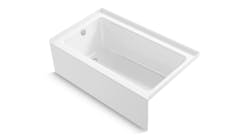Latest from Green
Sponsored
Pre-certified LEED hotel prototype reduces energy use, conserves water
BETHESDA, MD. — Marriott Intl. Inc. will soon have a LEED pre-certified hotel prototype, available in April 2010, for its Courtyard brand hotels. The prototype, which will guarantee the basic U.S. Green Building Council LEED certification level (owners can achieve a higher certification, depending on the site) will reduce a hotel's energy and water consumption by up to 25%, and save owners approximately $100,000 and six months in design time.
Scheduled to open this summer, the Courtyard Settler's Ridge in Pittsburgh, Penn., will be the first hotel built, based on the pre-certified LEED hotel prototype concept. Marriott plans to introduce similar green hotel prototypes this year for its Fairfield Inn, Residence Inn, SpringHill Suites and TownePlace Suites brands.
A green hotel prototype gives project managers a predetermined route, takes out the guess work and saves consultants time, as well as additional consultant fees in determining how to approach LEED, according to Jefferson B. Thomas, senior design manager of CFRST (Marriott's Select Service Brands) Design Management, A&C Division, and using a prescribed approach also saves cost on energy remodeling.
H.F. Lenz Co., the construction engineering services firm for the Settler's Ridge project, headquartered in Johnstown, Pa., suggested a heat recovery system with a roof top air handling unit and a guestroom bath exhaust system be utilized, according to Juliane D. Workley, project manager for the Courtyard Settler's Ridge and corporate director of A&C design at Concord Hospitality Enterprises Co., hotel owner/developer and third-party manager, based in Raleigh, N.C.
During the past few years, a guestroom bath exhaust system in a horizontal configuration with a constant draw of 30 cfm, produced by main exhaust fans at both ends of the corridors, was utilized. For the Settler's Ridge project, an additional exhaust was achieved by installing individual, locally switched, exhaust fans in each guestroom bathroom, providing an additional draw of 65 to 80 cfm.
“With the introduction of the heat recovery wheel into the outside air supply system, we were required to mechanically balance the cfm of supply and exhaust air to meet ASHRAE 62.1 outside air minimum ventilation requirements for LEED prerequisites,” explained Workley. “Therefore, the size of exhaust duct work was increased and balancing louvers were added as the individually switch exhaust fans in each room were eliminated.”
The public areas in the hotel are controlled by thermostats and are conditioned with five fan coil units and three air handling units suspended from the second floor deck, and supplemental heat is provided by two electric horizontal heating units in the main mechanical and electrical rooms, and electric wall heaters in entrance vestibules.
According to Workley, the energy-efficient features of the HVAC system are two 100% dedicated outside air system roof top units equipped with an energy recovery wheel that will reclaim heat energy from the guestroom bathrooms, and energy efficient fans in the units that provide additional energy savings when compared to the minimum requirements for ASHRAE 90.1.
“Energy saved by the HVAC system for space heating was about 72% and 30% for space cooling, interior fans contributed about 17% energy savings, but LEED energy calculations are based on the overall building and site energy use in dollars, higher U-values for glass, exterior insulation and roof insulation helped play a role in the overall energy savings for the HVAC systems,” said Workley. “The overall building energy savings was about 19% kWh, and the overall LEED energy savings in dollars was about 24%.”
Water conserving features in the hotel include 1.28 GPM water closets by Kohler, 1.5 GPM lavatory faucets by Simmons, and 2.0 GPM shower heads by Speakman, meeting the 25% water savings in LEED requirements.
Based on the LEED calculations, the annual water savings will be 319,275 gallons, according to Workley.
“We are very excited to have collaborated with Marriott on this significant initiative to help mold the Courtyard brand to be green for the future,” said Mark Laport, president and CEO, Concord Hospitality Enterprises Co. “We are committed to green building designs, which are now being incorporated at different levels in every building we develop. We expect to build many more LEED-certified hotels using this prototype in the future.”
According to Thomas, creating such a prototype was a long process, which started the end of 2007 when Marriott joined the U.S.GBC.
“We had the idea back then and had large meetings discussing the approach of sustainable design, and much of the development occurred in 2009,” explained Thomas. “Depending on the site conditions, owners can option for higher levels up to the highest level of Platinum.”
Even though the pre-certified hotel prototype is new to Marriott, the company has built several U.S.GBC LEED certified hotels prior to the prototype's introduction — in 2009, several Marriott LEED certified hotels opened, including the Fairfield Inn & Suites Baltimore Downtown/Inner Harbor, Maryland; the Ritz-Carlton Highlands Lake Tahoe, Truckee, Calif.; the Residence Inn Arlington Courthouse, Virginia; and Courtyard hotels in Chevy Chase, Md., Portland, Ore., and Pittsburgh. Several more LEED-certified hotels are expected to open in 2010.
Marriott also implemented the environmental strategy “Spirit to Preserve” in 2007. Initiatives include, but are not limited to, greening its $10 billion supply chain; reducing fuel and water consumption by 25% per available room; installing solar power at up to 40 hotels by 2017; and creating green construction standards for hotel developers to achieve LEED certification from the U.S. Green Building Council. Marriott is also pursuing LEED-Existing Building Silver status for its global headquarters office in Bethesda, Md., and planning to install solar photovoltaics in many of its California hotels.
Candace Roulo
Candace Roulo, senior editor of CONTRACTOR and graduate of Michigan State University’s College of Communication Arts & Sciences, has 15 years of industry experience in the media and construction industries. She covers a variety of mechanical contracting topics, from sustainable construction practices and policy issues affecting contractors to continuing education for industry professionals and the best business practices that contractors can implement to run successful businesses.

